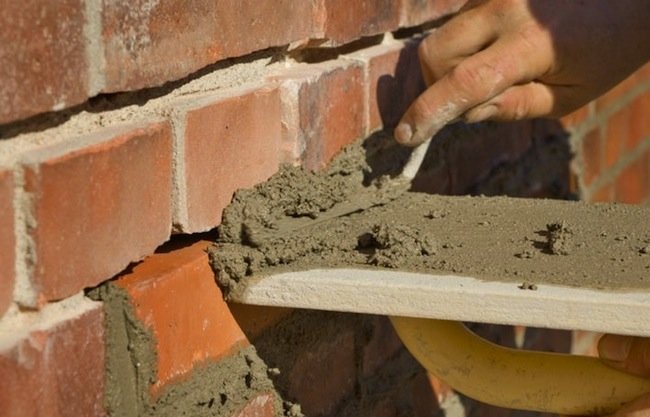

We may earn revenue from the products available on this page and participate in affiliate programs. Learn More ›
Brick houses are hard to damage. Anyone familiar with The Three Little Pigs knows that. Inevitably, however, there comes a time when the mortar between bricks begins to degrade. The process of repair, known as repointing, is pretty easy (if a bit time consuming). Undoubtedly, it’s a smart thing to do. That’s because crumbling mortar, if not fixed, allows water to seep in between the bricks, causing them to swell and crack and become generally blow-downable.
Here’s how to keep your brick walls standing tall.
Step 1: Remove The Old Mortar
Repointing is all about out with the old and in with the new—and working in small sections. You don’t want to remove all of the old mortar from a wall at once, because you may weaken its integrity. So, working along the wall in an area about three- to five-feet wide, remove the old mortar from both the horizontal and vertical joints.
To ensure you don’t damage the bricks, you can use a cold chisel or handheld grout saw to tap it out. You can also use another hand tool known as a joint raker. If you’re confident in your abilities, you can use a 4-inch angle grinder, but be careful not to cut into the brick.
You’ll want to remove the mortar to a depth of about 1/2 inch. Use a whisk broom, wire brush or hose to remove all the dust and wear a respirator to keep debris out of your lungs.

Step 2: Wet The Wall
Give your brick wall a good soaking with a hose and let it sit overnight. This will ensure that the bricks and old mortar are hydrated and that they don’t suck the water out of the new mortar you’ll place between them the next day. When you are ready to put in the new mortar, lightly spritz the bricks one more time before beginning.
Step 3: Mix The New Mortar
If your house is less than 50 years old, you will likely be safe using standard portland cement mortar to refill the spaces between your bricks.
If your abode is older than that however, you’ll want to use a different mix, consisting of lime and sand. This is what was originally used in brickwork and it’s best to use the same mix as a replacement. That’s because portland cement mortar is very hard when it dries and can cause older bricks to crack. The lime mix acts almost like disks between vertebrae in the spine: it cushions the brick and moves along with the wall as it flexes.
If you want to be sure you’re using the correct mortar replacement, you can check with a mason specializing in restoration work, or you can send a sample to be analyzed to a company like LimeWorks. Otherwise, a general rule of thumb is to make a mortar mix from 6 parts fine white sand, 2 parts lime and 1 part white portland cement.
No matter the mortar mix you use, be sure to make it in small batches as it hardens quickly. Place the ingredients in a wheelbarrow and mix to a frosting-like consistency whereby the mortar holds its peaks when you draw it upwards with a trowel.
Tip: Mortar sets up best in temperatures between 50 and 80 degrees, so you might want to do this project in the cooler months of the year.

Step 4: Insert The New Mortar
Pick up some mortar on a large trowel and then, using a pointing trowel, work smaller amounts into the horizontal and vertical gaps between the bricks. You might find it easier to fill the vertical joints with a tool known as a margin trowel. Use the flat edge of the trowel to even out your work and scrape off any mortar you get on the face of the bricks.
Step 5: Clean Up
Wait about an hour until the mortar has hardened a bit, then scrape off any mortar that’s remained on the brick face. You can do this with a sturdy wire brush, but be sure to use a horizontal sweeping motion so as to not pull the new mortar out of the joints. For the next three to four days, give the wall a daily misting to allow the mortar to dry slowly and not crack.
All in all, it’s a tedious, detailed job and you may find yourself huffing and puffing during it, but you’ll soon be satisfied that nobody and nothing will be blowing your brick house down anytime soon.
